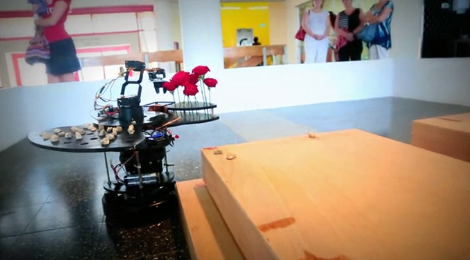
This robot was built to care for the graves and honor the dead in the Jewish tradition. It is called “Stoney” and was developed by [Zvika Markfeld] based on a concept by [Itamar Shimshony] who is working toward an MFA degree. The image above shows it in action as part of an installation; to our knowledge it has not been used for actual grave sites. But the concept is not a joke; it’s something that makes the observers think.
The base of the robot is an iRobot Roomba on top of which is built a platform for a robot arm. The arm has easy access to two palettes, one holds small stones, and the other flowers. There is also a small box which holds a rag. It navigates around the grave, placing stones, flowers, and using the rag and a water dispenser to symbolically clean the headstone. All of this is controlled by an Arduino Mega board which controls another Arduino running the arm, as well as the microcontroller in the Roomba.
The details of the ritual, as well as the components of the robot are well explained in the clip after the break.
















…what?
I’m struggling to write my actual thoughts about this project.
Scientifically if a person is dead there is not much more to say. Emotionally however there is much to say and do.
It makes no sense to me to have a robot handle the emotional aspect. Maybe the actual burying the dead, but not the tending.
I think that’s the point. It’s a statement of what we’re likely headed toward. A complete emotional tunnel through digital interfaces.
This is rather heart wrenching.
Bravo.
Fortunately this is only an “art” project. If it’s made to make one think… Well, I’m not familiar with this particular tradition, but I think there would be very little honor for the dead if a robot were to do it. And speaking as a realist, these kinds of things are more for the living than the dead anyway, so removing the living from participation also makes no sense.
Thank you Chris, you wrote it much better than i was able to.
Exactly. It’s not the existence of the flowers on graves that’s important, it’s the placement. At the same time, at lot of time and effort goes into making a robot, arguably more effort that goes into tending some cemeteries. This bot is interesting commentary on how society handles death.
When I saw the thumbnail and mistook the flowers for poppies, and it made me think of the robots used by the military to investigate/deal with IEDs. A lot of soldiers’ lives are saved by those things. I’ve read about guys getting very attached to those bots, to the point of naming them, and wanting them to be repaired rather than replaced after they get blown up (I read an article with a quote from a soldier that went something like “We don’t want a new robot, we want Scooby back”). Funny how people can feel a connection with what’s technically an inanimate object. I suspect there are people in the armed forces who wouldn’t object to one of these robots tending their grave. After all, robots literally can’t not do their duty, and it don’t get much more semper fi than that.
This is sort of related to something I’ve thought about for a long time – could maintenance robots be used to prolong the lives of structures in the absence of people? If you leave a yard (or a graveyard) untended for ten years, it will be a total mess – roots will have smashed up concrete, rain and wind will have eroded structures and so on. But even very basic ongoing maintenance like cutting weeds, covering things up during storms, applying paint and so on could vastly extend the lives of these places – think of a tombstone that lasts a thousand years, for example. If robots could be made to do that I think it would be really cool.
I agree with the above comments. When the robot does all the emotional parts, then what’s the point.
I could see a robot used to edge around the headstones and keep the grounds nice. It would be great to have a small team of robots keeping the grounds neat continuously instead of groundsmen doing it once a week. The cool thing about the robots working continuously is that if they sense a person coming out to pay respects, they can just park and be in quiet mode until the people leave.
I like the commentary so far; I think the artist would be pleased that their work is provoking these questions. When I was racing my bike through Japan I encountered Japanese Shinto grave yards with automated prayer figures, incense burning machines and mechanical chime ringers. Though automated I think these acts were still comforting to the living (and maybe even the dead). As such I don’t think this robot is much of a departure from what exists today.
– Robot
I’m in agreement with the first few comments.
I realize it’s a tangential thought,
But “Silent Running” pops into mind for me.
For a more whimsical display, the headstone could read “RIP Human Intervention.”
Eirinn’s comments, in the first post, align with my own – Im struggling to see how having this machine run would satisfy these traditions, however, as Bryan next alludes to, perhaps just knowing that this machine is doing these tasks could provide some self-satisfaction – but only to the extent that having an automatic cat-food dispenser makes me feel like I’m taking care of my pet.
I recently attended a “family trust” meeting, and one topic that was raised was whether to raise the pay of the local who mows the family gravesite – I never considered suggesting one of the Roomba-style mowers I believe exist.